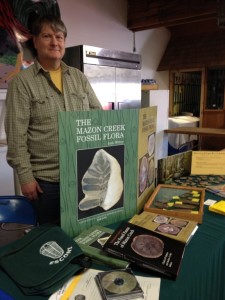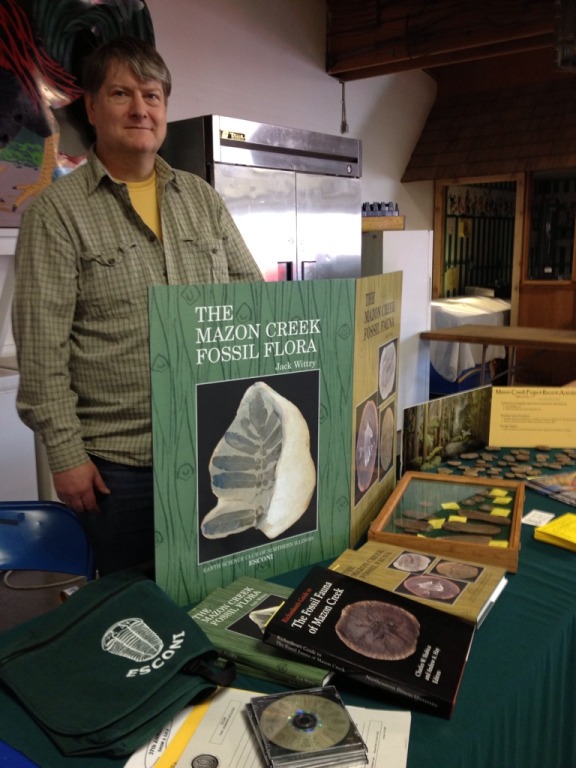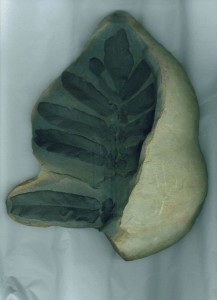By Mary Fairchild
In all North America, the Mazon Creek flora has the largest number of species and greatest taxonomic diversity of any Moscovian Pennsylvanian period assemblage. More than 200 species have been documented, of which the majority are fern and seed fern foliage.
Jack Wittry
Jack Wittry has written six scientific articles and has published two books on the Mazon Creek Fossils: The Mazon Creek Fossil Flora , and The Mazon Creek Fossil Fauna.
Mazon Creek was originally discovered by Joseph Evans in the late 1800s and later went on to be explored by famous amateurs George Langford and Francis Tully. The first specimens found along the banks of the Mazon River were plants, a few freshwater clams and crustacea.
George Langford, Curator of Fossil Plants, established a large collection at the Field Museum. Of the vast array of unique specimens found here, some are still undecided as to where to even place them in the animal kingdom. One in particular happens to be our own Illinois State Fossil, a strange wormlike “Tully monster” named after its collector, Francis Tully.
It would be “the amateurs” who would soon fill the Field Museum with thousands of specimens, many rare and unique. Their working relationship with the museum staff was initiated by the late staff scientist Dr. Eugene Stanley Richardson, Jr. who was the Curator of Vertebrate Paleontology at the Field Museum of Natural History in Chicago. Richardson had been the leader in exploring the fossil animals that were being discovered in the 1950s and 1960s amongst the coal mining operations southwest of the Mazon River. Before he passed away in 1983, he had recorded thousands of fossils for a projected book.
In 1967, Dr. Eugene Richardson and Dr. Ralph Gordon Johnson , University of Chicago professor, organized a National Science Foundation study. After systematically collecting at Pit 11 they discovered that the area unveiled “marine” fossils compared to more terrestrial forms found to the northeast. There was now a division made between the marine fossils (Essex fauna) and freshwater association (Braidwood fauna). In the following years, students would find many species of worms, crustaceans, and fish.
As a graduate student under Richardson and Johnson, Charles W. Shabica was to find out how Mazon Creek fauna lived and died. Detailed stratigraphic sampling combined with fossil census sampling by Gordon C. Baird allowed for the division of the Mazon Creek biota into several deltaic associations. The data showed a distinct regional boundary between estuarine (Essex) and freshwater and terrestrial (Braidwood) faunal assemblages paralleling the ancient shoreline.
Gordon C. Baird, professor of geology at State University of New York at Fedonia, in his article Mazon Creek Census writes:
“ …. as he motors along Interstate Highway 55. These hills, notable for their drabness and symmetry, are evidence of a system of abandoned coal mines that extends both across and under 40 square miles of Will, Grundy, Livingstone, and Kankakee Counties…To the paleontologist…these mined-out areas…contain abundant fossils, including forms that are both unusual and spectacular.” (Field Museum of Natural History Bulletin; Sept. 1978)
Gordon Baird did undergraduate education at Earlham College which introduced him to the famous Mazon Creek formation. Gene Richardson had a tremendous workforce on his side as the amateur collectors that were allowed access into Pit 11 would anxiously await to share their rare finds at the annual open house at the Field Museum.
Later, when Peabody sold coal pit 11 to Commonwealth Edison for the construction of a nuclear power-generating station, some collecting areas were lost. Area around the reactor cooling pond was leased, however, to the State of Illinois as a conservation area for fishing and fossil collecting.
Mazon Creek fossils occur within ironstone concretions. The animal and plant fossils here belong to the Pennsylvanian Period which is also called the “coal age” as extensive coastal swamps during this age developed and peat deposits formed that later turned into coal. Due to their rapid burial, many organisms were buried alive creating incredibly well-preserved specimens.
The concretions were buried in layers of shale that were stripped away during coal producing mining. Most of them ended up in spoil piles. The concretions filed buckets during the cold months of the year to allow gentle freezing and thawing to split them open.
This technique was first introduced by the late fellow amateur collector Larry Osterburger. It would be the “amateurs” who would soon fill the field museum with thousands of specimens, many rare and unique. Their working relationship with the museum staff was initiated by the late staff scientist Eugene S. Richardson.
The 1997 Richardson’s Guide to the Fossil and Fauna of Mazon Creek by Charles W. Shabica and Andrew A. Hay, was dedicated to the late Eugene Richardson who founded the Mazon Creek Project in the 1960s. The Mazon Creek Project was a program sponsored by Northeastern Illinois University. It was an attempt to encourage more communication between paleontologists and amateur collectors. The main goal of the project was to keep the Mazonia-Braidwood Conservation Area open for collecting by scientists, school children, scout groups, and visitors from other states.
“Mazon Creek Fossils hold a special place in paleontological record. Because conditions of life, of death, and of burial were unusually propitious, we find a more complete record of plant and animal populations than in most other fossil occurrences….I suppose that these elegant fossils have been collected…for centuries… But we have no inkling of any collections made by the Indians. The tradition that continues to the present has begun in the mid-nineteenth century, when there were already established towns and farms in the Illinois valley…” Eugene Richardson, The Mazon Creek Fossil Flora
Eugene Richardson described Jack Wittry as a “prolific collector” with a long standing interest in the taxonomy of the Mazon Creek flora. He has been welcomed to the Illinois State Museum, The Field Museum and The Smithsonian Institute to study and consult upon collections from this locality. His 2006 book is a welcomed and well-awaited update of the fossil flora of the Mazon Creek region of Illinois.
Jack Wittry began collecting fossils in his youth and has volunteered countless hours at the Field Museum where he freely shares his expertise and thousands of his fossils:Mazon Creek Fossil Invertebrates at the Field Museum of Chicago. He has written six scientific articles and has published two books:The Mazon Creek Fossil Flora , and The Mazon Creek Fossil Fauna with The Earth Science Club of Northern Illinois (ESCONI) which was founded in 1949.
“The Mazon Creek flora is renowned for being almost completely collected by amateurs. Since 1858, in an area covering approximately 100 square miles, untold numbers of collectors have gathered fossils in quantities unprecedented in North America.” Jack Wittry
In 2015 Wittry received the Strimple Award at the 127th Paloentological Society meeting at the Geological Society of Ameirca in Baltimore, Maryland. William A. DiMichele, Curator of Fossil Plants at the Smithsonian, and Ian Glasspool, former Head of Geological Collections, Adjunct Curator and Paleobotany Collections Manager at the Field Museum nominated Jack Wittry for the award. The Harrel S. Strimple Award recognizes outstanding achievement in paleontology by amateurs.
 “The Mazon Creek Fossil Fauna is a complete and updated taxonomic guide that includes descriptions and color photos of species that collectors are likely to find in the field or see in most large collections. This book was conceived by the Earth Science Club of Northern Illinois (ESCONI) as a continuation of earlier publications on the subject. It represents an evolution of Mazon Creek works published by ESCONI, including two books by George Langford, Sr. (1958 and 1963) and, more recently, Keys to Identify Pennsylvanian Fossil Animals of the Mazon Creek Area, ”
“The Mazon Creek Fossil Fauna is a complete and updated taxonomic guide that includes descriptions and color photos of species that collectors are likely to find in the field or see in most large collections. This book was conceived by the Earth Science Club of Northern Illinois (ESCONI) as a continuation of earlier publications on the subject. It represents an evolution of Mazon Creek works published by ESCONI, including two books by George Langford, Sr. (1958 and 1963) and, more recently, Keys to Identify Pennsylvanian Fossil Animals of the Mazon Creek Area, ”
Forward by Charles W. Shabica, Emeritus Professor, Northeastern Illinois University, Chicago, Illinois.
References and Related Events
- Chicagoland Gems & Minerals Association. A Family Friendly Show; Memorial Day Weekend; DuPage County Fairgrounds. Saturday-Sunday last weekend in May
- Dinner With Frederick Schram (Mazon Creek Fossils)
- Paul Sereno: African Dinosaurs Exhibit 2011
- PaleoFest at Burpee Museum, March Annual Festival in Rockford, IL.
- MAPS: Mid-America Paleontology Society. For the novice who wants to know more and the old-timers who have the knowledge and experience to share with the rest of us, the MAPS Fossil Expo is the largest show in the world that exhibits fossils exclusively. Usually held annually in March or April.
- ESCONI, the Earth Science Club of Northern Illinois. The ESCONI annual show is held annually in March.
- Lizzadro Museum Field Trip to Mazon Creek. March: Join Jim Fairchild of the Earth Science Club of Northern Illinois on a trip to collect Mazon Creek fossils. Learn what to look for when collecting these special fossils and how to open them. Travel by motor coach, bring a sack lunch and get ready to collect. Make reservations early, this field trip fills up fast! Reservations Required: (630) 833-1616. (Mazon Creek books for sale in bookstore.)
- Mazon Creek Fossil Invertebrates at the Field Museum of Chicago.
- Jack Wittry, The Mazon Creek Fossil Flora , Earth Science Club of Northern Illinois; 11/11/2006.
- Jack Wittry,The Mazon Creek Fossil Fauna , Earth Science Club of Northern Illinois; 10/22/2012.


